Patio paving ideas: 12 stylish ways with patio pavers to update your outdoor living space
Get your garden summer-ready with these patio paving ideas – from natural stone to porcelain pavers and more
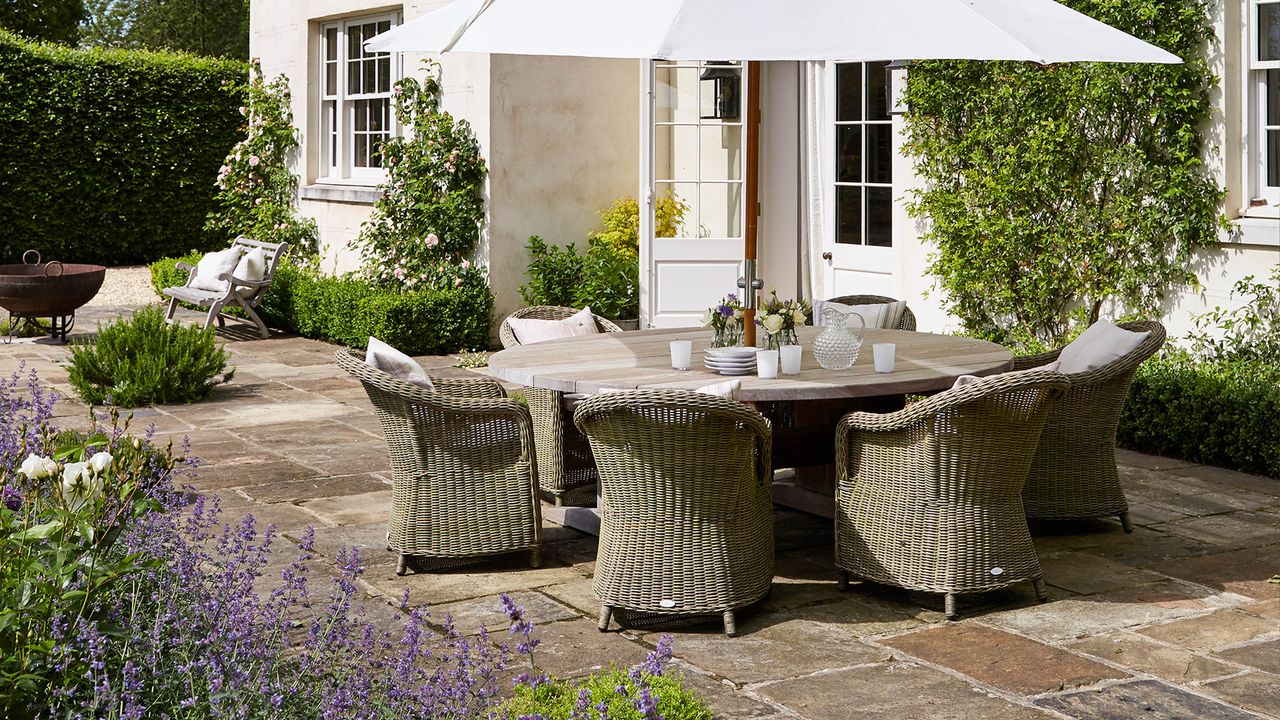

Picking the right patio paving ideas is a crucial part of planning an alfresco living area. There's no escaping it: they have a huge impact on the look and feel of a space. And, there are practicality issues to think about too – pavers may look gorgeous when first installed, but how easy are they to maintain?
Whether you're updating your current patio ideas with a fresh new look or are adding a brand new zone entirely, there are tons of designs to choose from to provide that all-important floor. From country-inspired cobbles to sleek porcelain styles and everything in-between, it's a big decision to make – but we're here to help.
Patio paving ideas: 12 designs for your plot
We've brought together some of our top patio paving ideas below. There's something for every theme and budget – you'll be sure to come away feeling inspired for your own backyard.
1. Go for moody tones

These elegant tiles are the Witton Noir 20mm Porcelain Paving Slabs from Walls & Floors
Deep and dark shades are so on-trend right now, giving a garden a sophisticated and sumptuous vibe.
These durable porcelain pavers are an ideal accompaniment to the charcoal fence, furniture and fire pit. But, rather than offering an uber-sleek and smooth look, they retain an element of rustic charm. This is due to the pattern within each tile, which offers the authentic effect of multiple, differently-sized stones. The natural finish also adds a pleasing texture – which works particularly well when choosing a monochromatic palette for a zone.
If you want to learn to install this type of paving yourself, then our guide on how to lay porcelain tiles outside has all the tips you need.
2. Or, opt for warmer-hued patio pavers
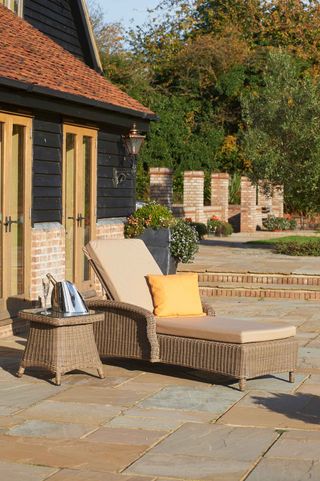
The Kensington sun lounger from Bridgman looks fantastic alongside warm-toned patio pavers
Prefer a warmer tone for your plot? When looking for patio paving ideas, larger slabs of natural sandstone might be the way forward.
These pavers offer a range of terracotta hues amongst shades of soft grey. Look for designs with a riven texture – where each stone is split along its layers – for a natural finish that will never go out of fashion.
As you can see, a style like this works beautifully alongside red brick features and natural-hued rattan furniture (our buying guide for the best sun loungers has lots of choice if you fancy an upgrade). Just make sure you keep on top of maintenance to keep it looking its best. For these pavers it's not too tricky, but our guide on how to clean a patio has step-by-step advice should you need it.
3. Try smoother styles in natural stone
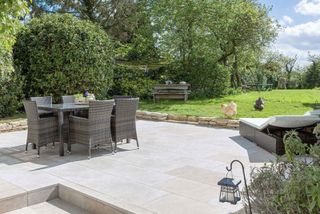
The Dijon Tumbled Limestone pavers from Quorn Stone are an elegant choice for patio paving ideas
For slightly more modern garden ideas, you may choose to go for a brighter finish for your patio pavers. These slabs shown above are made from limestone, and offer a pale stretch of paving that is nothing short of elegant.
They have been produced with a 'tumbled' effect, which means that there is a slight grip underfoot – useful if you live in a rainy region and aesthetically pleasing, too. As Isabel Fernandez, Director at Quorn Stone says, a paver like this bodes well for a traditional or country-style property. From this set-up above we can wholeheartedly agree – it looks perfect alongside a drystone wall and classic furniture, and offsets a lush green lawn beautifully.
4. Choose a more rustic look for traditional patios

Earthy-toned pavers work well in this space
Darker-colored natural stone pavers are also a good choice for a country-classic look. This is particularly the case if your home's exterior has lots of pale-colored features – mocha-toned pavers will ground the space and offer a sense of balance.
There are plenty of varieties available that are designed specifically for a reclaimed effect. Go for a mix of sizes and a subtle range of shades for extra character.
Surround with plenty of patio gardening ideas for a pop of vibrancy – using climbers up a wall is a great way to maximize space.
5. Go classic with cobbles
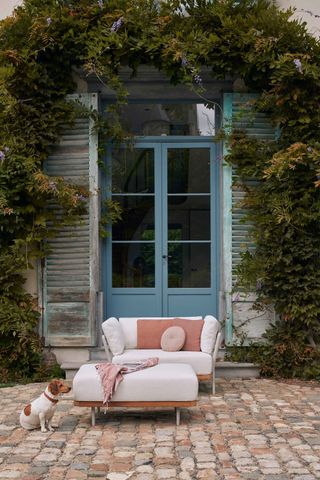
Cobblestones are a well-loved choice for a traditional look and look great with the Outdoor Garden Modern Designer Loveseat and Stool from Juliettes Interiors
If you love cottage garden ideas as much as we do, then cobblestones make a fabulous choice for your patio pavers. With their rounded edges, they ooze with eclectic, traditional charm and tend to be very durable. They normally allow rainwater to permeate through too, which can help reduce puddling and pooling.
However, they are rather labor-intensive to lay, and unless you get lucky by finding reclaimed styles for cheap, they tend to be expensive.
6. Or, choose carpet stones for an easy option
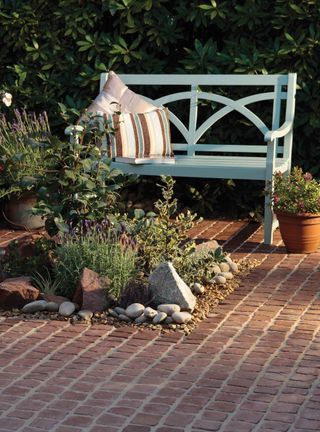
Carpet Stones from Bradstone offer a quick and easy cobblestone effect
So, the idea of cobblestones has got you feeling inspired for your own garden. But, if you want to learn how to lay a patio yourself, then all the work of laying them can be a little off-putting. Well, you'll be pleased to know that there's a (rather ingenious) solution.
These are called carpet stones, and provide all the charm of cobbles yet are much quicker and easier to lay. Why? They're pre-laid on an underlying flexible mat, which can be cut and shaped to fit your space using a humble pair of scissors. All you need to do is interlock the mats for that quintessentially-rustic look.
7. Pick your furniture to match
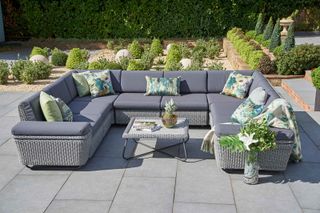
A stunning corner sofa set from Bridgman
For a super-cohesive look, match your patio paving ideas to your garden furniture ideas. It's a simple trick but will instantly bring bags of style to your space.
These large grey pavers are the perfect match for the generous corner sofa: the effect is fuss-free and practical yet considered – a great choice for family garden ideas. Bring a boost of color into the mix with accessories – cushions will provide an easy update, as will garden planter ideas dotted around the zone.
8. Break up your patio pavers with greenery
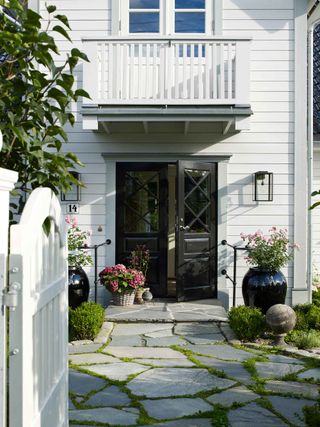
This striking paving offers a unique look
Bring a stylish twist to your modern paving ideas by filling the gaps between them with greenery. Sedum is a popular choice for this style as it's hardy and low-maintenance. But, you can also try creeping thyme for its pleasing fragrance, or chamomile.
Alternatively, try the dwarf variety of mondo grass which is another easy-care choice and will offer lush green growth all year-round.
As for the patio pavers themselves, irregular shapes will offer a more 'old-world' look. However, you could also choose to use strips of planting within more orderly-styled paving for a clean and contemporary scheme.
9. Introduce decking-effect designs

The Madera Antigua pavers from Bradstone are made to look like decking, but are much easier to maintain
Did you know that you can use patio pavers to recreate the look of decking ideas? Yes, it's true!
Porcelain tiles like these will bring an authentic, timber-effect appearance to your outdoor living space. But, maintenance is much easier, as there's none of the warping, rot, or staining which can occur when using real wood.
Complement the polished look with a comfy outdoor sofa and a central fire pit to keep things cozy. We adore this coffee-table design, but our fire pit ideas feature has lots more inspiring styles.
10. Use block paving for a pleasing pattern
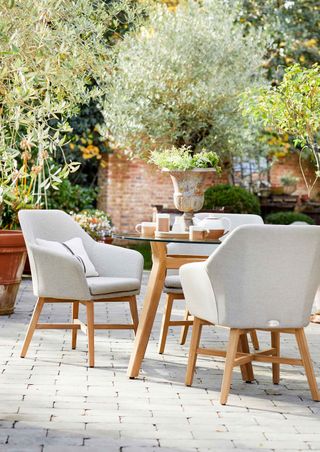
The Henley glass and teak table and Richmond chairs from Bridgman make a great match for this pale block paving
Block paving is another option when it comes to patios, and is a perfect choice for small garden ideas. It's super-tough (often used for driveways), but can look lovely for a living space, too.
Due to the smaller size of the stones, they offer a more intricate pattern once installed which can provide a pleasing point of interest. Opt for light tones to keep it feeling pared-down and mirror the colors with your furniture for a grown-up look.
11. Link indoors with out

The Silver Cloud Softly Limestone tiles from Quorn Stone can be used to create a sense of flow
Nowadays, you can find plenty of patio pavers that work inside just as well as they do out. So, if seamless outdoor living sounds appealing to you, then try using the same paving either side of your back door.
These silvery-hued designs are made from hard-wearing limestone and are great for disguising dirt and dust. Their straight-cut edge makes it simple to achieve a smooth finish and there's a slight texture to their surface, too.
It's the perfect practical base for stunning outdoor living space ideas – ready to dress up with furniture and accessories however you wish.
12. Try something circular
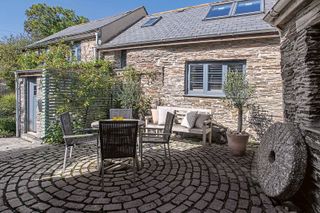
Grey cobblestones add tons of charm to this scene
Patios don't have to be square, so if you fancy something a little different for your landscaping ideas, then think about introducing curved shapes instead.
This circular zone is ideal for a dining spot and is full of traditional character. Plus, it's sympathetic to the exterior of the home, too – always a good factor to consider when choosing your pavers.
What should you consider when choosing paving for your patio?
'There are a number of things to consider before choosing your patio, from the style and color to the materials and volume you need,' says Lee Dunderdale, Product Manager at Bradstone.
'To complement your home's exterior, opt for a material and color which suits,' Lee advises. 'For example, natural stone in buff tones goes well with a more traditional home, while grey porcelain or concrete often better suit a newer property.'
Isabel Fernandez, Director at Quorn Stone, agrees with picking patio paving ideas to suit your property. She suggests how a contemporary home will likely suit a straight-cut porcelain paver with low tonal variation.
Lee continues: 'Whilst style is important, also consider the function of your new patio – will it be for lounging and a few pots, or will it be used to entertain, with barbecue wheels and chair legs frequently moving over the surface? Also, keep in mind your budget, as this will often dictate what material you buy and how big your patio can be.' If you're looking for ways to save, our budget patio ideas feature has plenty, whilst our guide on how much does a patio cost is full of useful info.
Before deciding on your new paving product, Lee suggests to speak to your chosen landscaper to seek their guidance too. 'It's likely they will also be able to recommend products or materials that will best suit your needs.'

An outdoor rug and grey sofa set from The Range complement this paving choice beautifully
It's also important to consider the maintenance aspect, says Isabel. This is especially the case if you're looking for low maintenance garden ideas. 'A porcelain paver is extremely popular due to its minimal maintenance (no sealing required),' she says. Plus, the low porosity and UV-stable properties means that porcelain pavers won't stain or change color over the years with sunlight exposure.
'A natural stone paver does require a little more maintenance,' continues Isabel, ' – typically a coat of sealant each spring.' However, the texture and individuality of each natural stone paver makes this a classic choice that will naturally weather and stand the test of time, she adds.
Isabel suggests to consider the slip-resistance of your pavers too. 'A porcelain paver is often produced in a 'grip' finish (also known as an R11 rating),' she explains. 'This finish is designed for external use and helps to provide more grip in wet conditions.'
'A natural stone paver can come in a wide variety of finishes – some offer more texture than others,' she continues. 'we usually recommend a 'tumbled' or 'seasoned' finish as these strike the balance of providing grip whilst still being comfortable underfoot.'
Juliette Thomas, Founder and Director of Juliettes Interiors, shares her tips – which are particularly handy when choosing patio paving ideas for smaller spaces: 'Sleek, contemporary paving is very much my style – and very on trend too. Nero porcelain or Kandla grey sandstone would be my favorites. They make a patio look more open and spacious. I would avoid any fussy patterns and go for simple, straight lines, particularly with a small patio.'
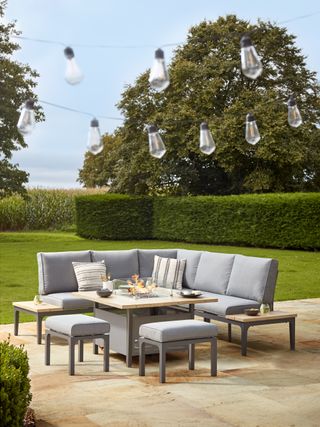
Warm stone offsets this set-up from Cox & Cox perfectly
Is concrete a good choice for patios?
'Concrete paving is a great choice for patios,' says Lee Dunderdale, Product Manager at Bradstone. 'It is hard-wearing, durable and strong and is therefore perfect for patios required for entertaining or for areas with heavy footfall, such as a path or bin storage area.'
'It can also be a more cost-effective option with a greater range of price points available,' Lee continues. Plus, there are plenty of concrete styles which vary in color and design to suit both contemporary and traditional properties. You can also find eco-friendly versions on the market – our eco paving tips feature has all you need to know.

The garden was always a big part of Holly's life growing up, as was the surrounding New Forest where she lived. Her appreciation for the great outdoors has only grown since then. She's been an allotment keeper, a professional gardener, and a botanical illustrator – plants are her passion.
